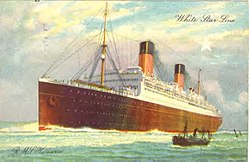RMS Homeric
|
Color drawing of the Homeric
|
||||||||||||||||||
|
||||||||||||||||||
|
||||||||||||||||||
|
||||||||||||||||||
|
||||||||||||||||||
The RMS Homeric was a White Star Line ship . It was originally built for North German Lloyd as Columbus (also spelled Columbus ).
Ship life
Wartime
The North German LLoyd employed four splendid express steamers on the North Atlantic in 1913, as well as a few combined passenger and cargo steamers for normal service to New York. One of them was supposed to be the Columbus , actually a little too big for this secondary service. However, the shipping company had good experiences with the steamer George Washington , a 25,000-tonne crane with an economical speed of 18 knots, which had proven itself extremely well in the service to New York, which was a little slower than the express service.
That gave the impetus to order the Schichau shipyard in Danzig to build two large ships at an economical speed. The first of these ships was christened Columbus on December 17, 1913 . When the war broke out in August 1914, the ship was about 80 percent ready, and it remained in this state of construction until the end of the war.
Further construction after the war / Columbus Agreement
The unfinished ship was ceded to Great Britain at the end of the war and bought by the British state in 1920 through the White Star Line.
The ship itself was still in Danzig. The shipping company had a great need for tonnage , firstly because of the many war losses and secondly because the loss of the Titanic still had to be compensated. The construction of the Columbus at the German shipyard was very slow in 1919, because the company and the workers did not show any great enthusiasm for a ship that they knew would fall into the hands of the former enemy. White Star Line inspectors came to the shipyard in Gdansk to monitor the construction work. Finally, on August 5, 1921, the so-called Columbus Agreement between the Germans and the British came about. The German government and Norddeutsche Lloyd promised to use their influence for a speedy completion of the ship and not raise any legal concerns - Danzig was no longer part of the German Reich (more details here ). In exchange for these commitments, the English side waived the delivery of the sister ship Hindenburg , which North German Lloyd operated under the name Columbus after completion , and of six ships of the NDL that had spent the war in South America. These were the former Reichspost steamers Seydlitz (7,942 BRT / 03) and Yorck (8,901 BRT / 06), the Gotha (6,653 BRT / 07) used for the Río de la Plata and the freighters Göttingen (5,441 BRT / 07), Westphalia ( 5,112 GRT / 05) and Holstein (4,932 GRT / 11). These six ships were more important for the reconstruction of the NDL than the slow giant steamer.
On January 21, 1922, the ship first entered Southampton . Shortly afterwards, on February 15th, the maiden voyage to New York went .
Ship equipment
In the meantime, the ship's name had also been adapted to the typical names of the White Star ships and changed to Homeric . At 34,000 GRT, the Homeric looked impressive. It had five continuous decks, above the bridge deck and the boat deck with other smaller superstructures on top. 14 watertight bulkheads made for a good subdivision of the hull and with six hatches and holds there was sufficient storage space. The cabins were well equipped and divided for 1st, 2nd and 3rd class passengers, of which 1st class was accommodated amidships and the other passengers further back. Most of the social rooms were on the bridge and boat deck.
After an overhaul in 1923, the speed could be increased to 19.5 knots, with which she could be promoted to the express steamer , because from now on she was used together with the giants Majestic and Olympic as a fast steamer of the White Star Line to New York. The fact was, however, that the ship had not been built for the express service , so she always remained the slowest of the fast steamers . A third ship was needed, however, and because of her size, only the Homeric could be used.
Ship life
With her shipping company and also with the passengers she acquired a good reputation as a reliable ship until the global economic crisis and the subsequent recession set in and not as many express steamers were needed anymore. She made her last Atlantic crossing in January 1932 and henceforth limited herself to cruises . It was well suited for this because of its well-equipped living space and economical machinery.
In 1934 Cunard and White Star Line merged. The Homeric continued cruising until September 1935, then - after only 13 years of service - it was decommissioned and launched and scrapped in 1936.
The sister ship
The sister ship, which actually Hindenburg was to be called, and shortly after Columbus was keels were laid later took the name of his in England ceded predecessor and was as Columbus while trying to Germany to break through on December 19, 1939 320 nautical miles east of Cape Hatteras on the Crew sunk themselves . Between 1935 and 1939, when the ship was anchored in Valpariso, it was a popular meeting place for German emigrants living there.
Web links
Footnotes
- ↑ Reclam's universe world tour . Reclam, Leipzig 1913 (issue 13, p. 603).
- ↑ Wording of the contract.
- ^ Arnold Rehm: The Columbus Agreement of August 5, 1921 (Bremisches Jahrbuch, 49th volume (1964), p. 210ff.)


